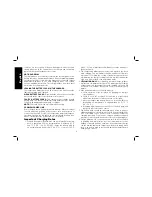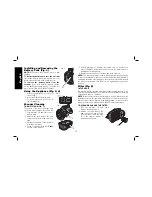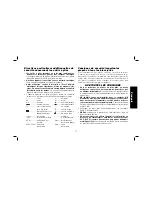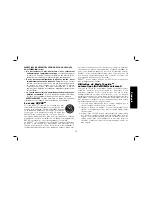
b. and the battery liquid gets into your eyes, flush them with
clean water for a minimum of 10 minutes and seek immediate
medical attention. (
Medical note:
The liquid is 25–35%
solution of potassium hydroxide.)
SPECIFIC SAFETY INSTRUCTIONS FOR LITHIUM ION (Li-Ion)
•
Do not incinerate the battery pack even if it is severely
damaged or is completely worn out.
The battery pack can
explode in a fire. Toxic fumes and materials are created when
lithium ion battery packs are burned.
•
If battery contents come into contact with the skin,
immediately wash area with mild soap and water.
If battery
liquid gets into the eye, rinse water over the open eye for
15 minutes or until irritation ceases. If medical attention is needed,
the battery electrolyte is composed of a mixture of liquid organic
carbonates and lithium salts.
•
Contents of opened battery cells may cause respiratory
irritation.
Provide fresh air. If symptoms persist, seek medical
attention.
WARNING:
Burn hazard. Battery liquid may be flammable if
exposed to spark or flame.
The RBRC™ Seal
The RBRC™ (Rechargeable Battery Recycling
Corp oration) Seal on the nickel cadmium, nickel metal
hydride or lithium ion batteries (or battery packs)
indicate that the costs to recycle these batteries (or
battery packs) at the end of their useful life have already
been paid by D
E
WALT. In some areas, it is illegal to
place spent nickel cadmium, nickel metal hydride or lithium ion
batteries in the trash or municipal solid waste stream and the RBRC
program provides an environmentally conscious alternative.
RBRC™, in cooperation with D
E
WALT and other battery users, has
established programs in the United States and Canada to facilitate
the collection of spent nickel cadmium, nickel metal hydride or lithium
ion batteries. Help protect our environment and conserve natural
resources by returning the spent nickel cadmium, nickel metal
hydride or lithium ion batteries to an authorized D
E
WALT service
center or to your local retailer for recycling. You may also contact
your local recycling center for information on where to drop off the
spent battery.
RBRC™ is a registered trademark of the
Rechargeable Battery
Recycling Corporation.
Using Automatic Tune-Up™ Mode
(NiCd/NiMH only)
The automatic Tune-Up™ Mode equalizes or balances the individual
cells in the battery pack allowing it to function at peak capacity.
Battery packs should be tuned up weekly or after 10 charge/
discharge cycles or whenever the pack no longer delivers the same
amount of work. To use the automatic Tune-Up™, place the battery
pack in the charger and leave it for at least 8 hours. The charger will
cycle through the following modes.
1. The red light will blink continuously indicating that the 1-hour
charge cycle has started.
2. When the 1-hour charge cycle is complete, the light will stay on
continuously and will no longer blink. This indicates that the pack
is fully charged and can be used at this time.
3. If the pack is left in the charger after the initial 1-hour charge,
the charger will begin the Automatic Tune-Up mode. This mode
continues up to 8 hours or until the individual cells in the battery
pack are equalized. The battery pack is ready for use and can be
removed at any time during the Tune-Up mode.
4. Once the Automatic Tune Up mode is complete, the charger will
begin a maintenance charge; the red indicator will remain lit.
English
5
Summary of Contents for DCV580
Page 2: ......








































